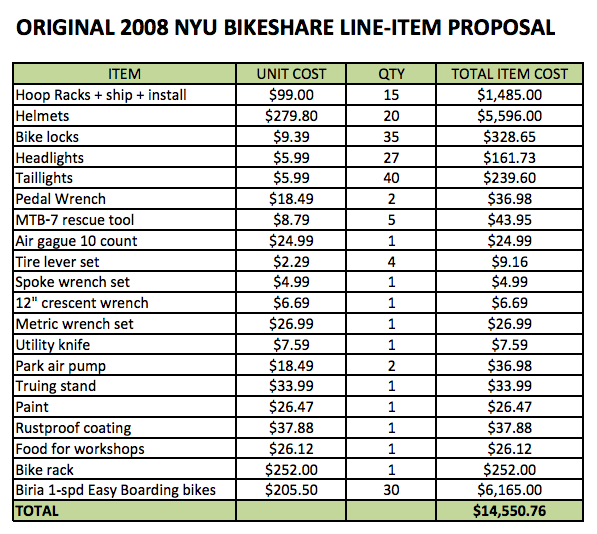Lafayette Bike-Library (DIY)
We have established that Lafayette College is a relatively small educational institution in which community members should not have the need for a car. The college has been trying to transition into a more walking friendly campus; examples of this including transforming the roads in front of Pardee and Anderson Courtyard into a brick pathway and lawn, respectively. Implementing a bike-share system on campus would further enforce the College’s mission; however, while outsourcing a company can ensure for a successful system, the idea of creating their own system should not be disregarded. Schools such as New York University (NYU), have successfully created and maintained their own bike systems, and due to their success, are currently expanding them. Looking to these schools for guidance will assist Lafayette in implementing its own, equally successful bike-share system.
NYU’s bike-share system was operated by two graduate students and was comprised of thirty refurbished bicycles and a software system that enabled students to swipe their card to check out a bike from the U-locked docking station. Additionally, students can reserve bikes through a web-based system.
Shown above, is a complete list of costs for NYU’s system. This was financed primarily through a grant of $13,000. Today NYU’s bike share program has expanded to several different areas in Manhattan along with one in downtown Brooklyn. NYU’s success is a positive reinforcement that it can be done, especially since NYU’s 54,000 students far outweighs Lafayette’s 2,500; Lafayette would not need nearly as much funding or bikes to create a successful program.
How much will it cost and how will it work?
There are several possible Do-it-Yourself style solutions available. One is a checkout system such as that at NYU in which individuals use their college ID cards to check out a bike from the docking station. Another solution is for a bike could be treated the same way as checking out a book; the user simply asks the student behind Skillman’s front desk to rent a bike for the day.
Concerning funding, NYU was able to create a free membership for its students and faculty members, but because Lafayette is such a small community there may need to be a small surcharge for membership, ranging anywhere from ten dollars for the semester to twenty dollars for the semester; however, in comparison to the $200 per semester needed to park a car on campus, this becomes a financially sensible option.
The optimal location for such a system is at the already-installed bike rack in front if Skillman library. This is ideal because it is close to many of the academic buildings, the quad, dining halls, and the student center and as stated before, the student librarians could check out the bikes to students the same way as a book. In terms of cost, this system ranges widely primarily based on the quality of the bikes. If the college would like to purchase new bicycles the cost roughly range anywhere from $200 to $1,000. Lafayette would also need to create a housing system for bikes along purchasing utilities such as helmets, a bike rack for the hub, locks for the bikes along with several tools for on campus quick fixes. Overall the college will be looking as a roughly estimated cost of $10,000 for a self run and implemented bike-share system. Finally, in terms of maintenance, Lafayette would have to either hire a full-time mechanic or establish a relationship with a local bike shop. Since such an arrangement could potentially be very expensive, Lafayette could build a shed or housing for the bikes to protect them from the elements, thereby reducing repair costs.
___________________________________________________________________
To navigate accross the page please use the following links:
• Bike-share Meets Lafayette
• The Team
• Defining the Scope
• Challenges and Mitigating Factors
• Solutions
• Conclusion
• Bibliography

